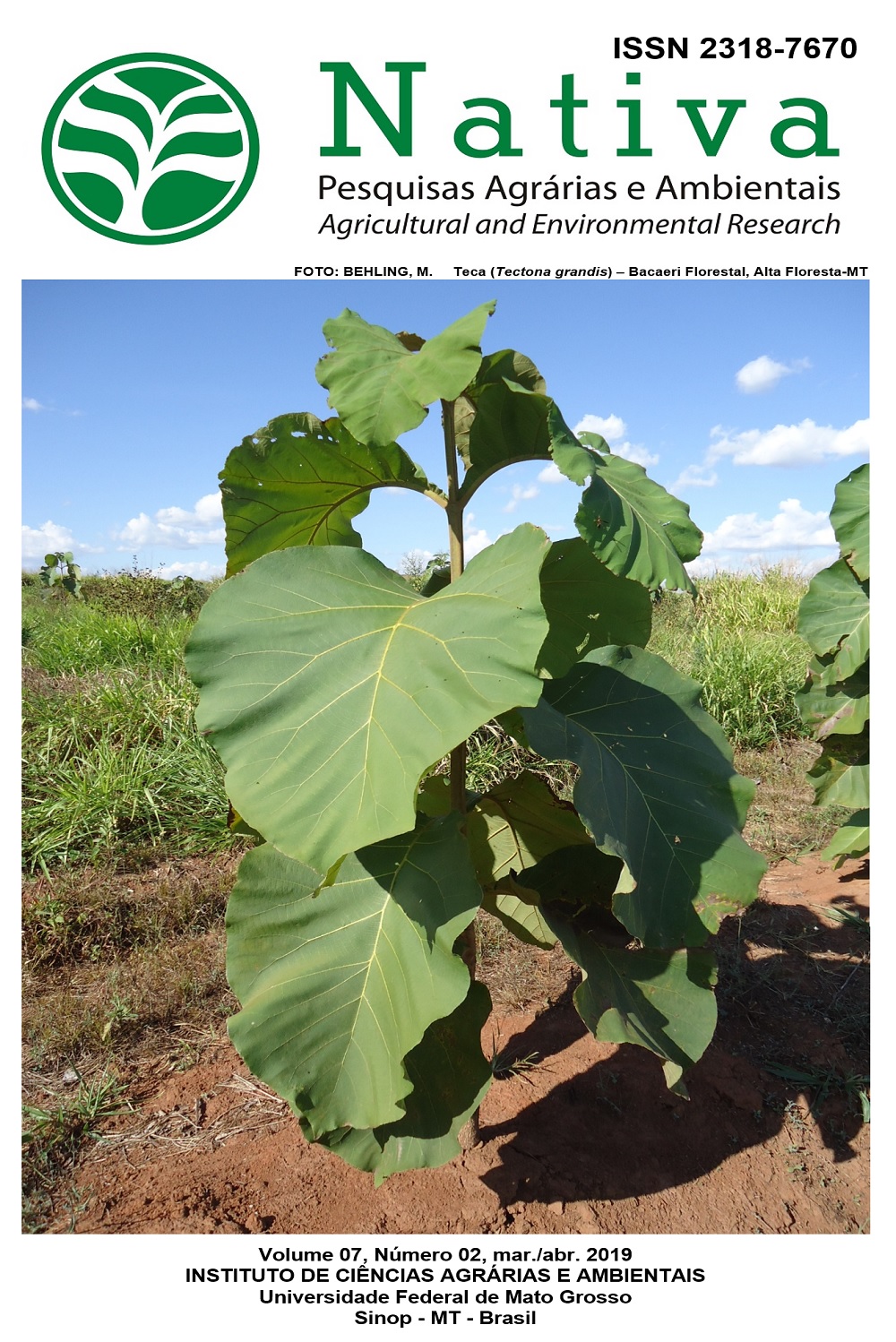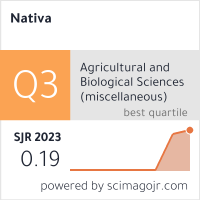DESENVOLVIMENTO DE CULTIVARES DE SOJA APÓS INOCULAÇÃO DE ESTIRPES DE Bacillus subtilis
DOI:
https://doi.org/10.31413/nativa.v7i2.6261Resumo
O uso de bactérias diasotróficas na agricultura pode promover incrementos de produtividade das culturas. Este estudo teve por objetivo avaliar o efeito de diferentes concentrações de inoculantes a base de rizobactérias Bacillus subtilis no desenvolvimento inicial da cultura soja. Foram conduzidos dois experimentos com variedades comerciais de soja, M8210 e TMG132, avaliadas aos 15, 30 e 45 dias após semeadura (DAS). Em cada experimento, aplicou-se dois produtos no tratamento de sementes, um contendo a bactéria Bacillus subtilis estirpe pant001 nas concentrações de 0, 2, 4, 6 e 8 mL kg-1, e o tratamento adicional com um fungicida protetor comercial, que também possui Bacillus subtilis estirpe QST713 na sua formulação, na dose recomendada de 2 mL kg-1. Avaliou-se o índice Spad de clorofila de folhas do terço superior, médio e inferior do dossel aos 15, 30 e 45 DAS, a altura de plantas, fitomassa fresca e seca da parte aérea das plantas, fitomassa fresca e seca de raízes e volume de raízes aos 30 e 45 DAS. Os resultados indicaram aumento do índice Spad de clorofila das folhas de ambas as variedades com aumento das doses de Bacillus subtillis pant001, porém a inoculação não surtiu efeito sobre os atributos da parte aérea das plantas. Na variedade TMG132, houve incrementos na massa fresca de parte aérea após os 30 DAS e volume de raízes aos 45 DAS.
Palavras-chave: Glycine max L., rizobactérias, tratamento de sementes.
DEVELOPMENT OF SOYBEAN CULTIVARS AFTER INOCULATION WITH STRAINS OF Bacillus subtilis
ABSTRACT:
Diasotrophic bacteria in agriculture can promote increases in crop productivity. This study aimed to evaluate the effect of different concentrations of Bacillus subtilis rhizobacteria inoculants on the initial development of two soybean cultivars. Two experiments were conducted with commercial soybean varieties, M8210 and TMG132, evaluated at 15, 30 and 45 days after sowing (DAS). In each experiment, two products were applied in the treatment of seeds, a Bacillus subtilis strain pant001 at concentrations of 0, 2, 4, 6 and 8 mL kg-1, and the additional treatment with a commercial protective fungicide, which also has Bacillus subtilis strain QST713 in its formulation at the recommended dose of 2 mL kg-1. The leaf chlorophyll content index of the upper, middle and lower canopy was evaluated at 15, 30 and 45 DAS, height of plants, fresh and dry mass of the aerial part of the plants, fresh and dry root mass and volume roots at 30 and 45 DAS. The results indicated an increase in the Spad index of leaf chlorophyll of both varieties with increasing doses of Bacillus subtillis pant001, but the inoculation had no effect on the attributes of the aerial part of the plants. In the TMG132 variety, there was an increase in fresh shoot mass after 30 DAS and root volume at 45 DAS.
Keywords: Glycine max L., rhizobacteria, seed treatment.
Referências
ARAÚJO, F. F.; MARCHESI, G. V. P. Uso de Bacillus subtilis no controle da meloidoginose e na promoção do crescimento do tomateiro. Ciência Rural, Santa Maria, v. 39, v. 5, p. 1558-1561, jul./ago. 2009. DOI: http://dx.doi.org/10.1590/S0103-84782009000500039
ARAÚJO, F. F. D.; MARCHESI, G. V. P. Uso de Bacillus subtilis no controle da meloidoginose e na promoção do crescimento do tomateiro. Ciência Rural, Santa Maria, v. 39, n. 5, p. 1558-1561, ago. 2008. DOI: http://dx.doi.org/10.1590/S0103-84782009000500039
ARAÚJO, F. F.; HUNGRIA, M. A. Nodulação e rendimento de soja co-infectada com Bacillus subtilis e Bradyrhizobium japonicum / Bradyrhizobium elkanii. Pesquisa Agropecuária Brasileira, Brasília, v.3 4, n. 9, p. 1633-1643, 1999. DOI: http://dx.doi.org/10.1590/S0100-204X1999000900014
BOUMA, T. J.; NIELSEN, K. L.; KOUTSTAAL, B. A. S. Sample preparation and scanning protocol for computerised analysis of root length and diameter. Plant and Soil, v. 218, n. 1-2, p.185-196. 2000. DOI: https://doi.org/10.1023/A:1014905104017
JAIZME-VEJA, M. D. C.; RODRÍGUEZ- ROMERO, A. S.; GUERRA, M. S. P. Potential use of rhizobacteria from the Bacillus genus to stimulate the plant growth of micropropagated bananas. Fruits, San Cristóbal de La Laguna, v.5 9, p. 83-90, mar. 2004. DOI: https://dx.doi.org/10.1051/fruits:2004008
JARDIN, P. Plant biostimulants: definition, concept, main categories and regulation. Scientia Horticulturae, Amsterdam, v. 196, p. 3-14, 2015. DOI: https://dx.doi.org/10.1016/j.scienta.2015.09.021
JUAN, M.; CHOU, C. C. Enhancement of aglycone, vitamin K2 and superoxide dismutase activity of black soybean through fermentation with Bacillus subtilis BCRC 14715 at different temperatures. Food Microbiology, London, v. 27, n. 5, p. 586-591, 2010. DOI: http://dx.doi.org/10.1016/j.fm.2009.11.002
KHEDHER, S. B.; KILANI-FEKI, O.; DAMMAK, M.; JABNOUN-KHIAREDDINE, H.; DAAMI-REMADI, M.; TOUNSI, S. Efficacy of Bacillus subtilis V26 as a biological control agent against Rhizoctonia solani on potato. Comptes rendus biologies, Paris, v. 338, n. 12, p. 784-792, dec. 2015. DOI: https://dx.doi.org/10.1016/j.crvi.2015.09.005
KUHN, O. J.; PASCHOLATI, S. F. Custo adaptativo da indução de resistência em feijoeiro mediada pela rizobactéria Bacillus cereus ou acibenzolar-S-metil: atividade de enzimas, síntese de fenóis e lignina e biomassa. Summa Phytopathologica, Botucatu, v. 36, n. 2, p.107-114. 2010. DOI: http://dx.doi.org/10.1590/S0100-54052010000200001
LAL, R. Sequestering carbon in soils of arid ecosystems. Land Degradation & Development, Medford, v. 20, n. 4, p. 441-454, jun./jul. 2009. DOI: https://dx.doi.org/10.1002/ldr.934
OLIVEIRA, G. R. F.; SILVA, M. S.; MARCIANO, T. Y. F.; PROENÇA, S. L.; SÁ, M. E. Crescimento inicial do feijoeiro em função do vigor de sementes e inoculação com Bacillus subtilis. Revista Brasileira de Engenharia de Biossistemas, Tupã, v. 10, n. 4, p. 439-448, out. 2016. DOI: http://dx.doi.org/10.18011/bioeng2016v10n4p439-448
PAVAN, M. E.; PETTINARI, M. J.; CAIRÓ, F.; PAVAN, E. E.; CATALDI, A. A. Bacillus anthracis: una mirada molecular a un patógeno célebre. Revista argentina de microbiología, Ciudad Autónoma de Buenos Aires, v. 43, n. 4, p. 294-310, 2011.
PROVENZA, F. D.; VILLALBA, J. J. The role of natural plant products in modulating the immune system: an adaptable approach for combating disease in grazing animals. Small Ruminant Research, Amsterdam, v. 89, n. 2-3, p.131-139, abr. 2010. DOI: https://dx.doi.org/10.1016/j.smallrumres.2009.12.035
SCHEFER, A.; CIPRIANI, K.; CERICATO, A.; SORDI, A.; RESCHKE LAJÚS, C. Eficiência técnica e econômica da cultura da soja submetida à aplicação de fertilizantes nitrogenados em semeadura e cobertura. Scientia Agraria, Curitiba, v. 17, n. 2, p. 14-20, abr./mai. 2016. DOI: http://dx.doi.org/10.5380/rsa.v17i2.45413
SHAPIRO, S. S.; WILK, M. B. An analysis of variance test for normality (complete samples). Biometrika, v. 52, n. 3-4, p. 591-611. dez. 1965.
THOMAS, A. L. Modificações morfológicas e assimilação de nitrogênio em plantas de soja (Glycine max.) com sistemas radiculares sob deficiência de O2. 2004. 87f. Tese (Doutorado em Biologia Vegetal) – Universidade Estadual de Campinas, Campinas, 2004.
Downloads
Publicado
Edição
Seção
Como Citar
Licença
Direitos Autorais para artigos publicados nesta revista são do autor, com direitos de primeira publicação para a revista. Em virtude de a aparecerem nesta revista de acesso público, os artigos são de uso gratuito, com atribuições próprias, em aplicações educacionais e não-comerciais.
A artigos publicados nessa revista, podem ser reproduzidos parcialmente ou utilizados como referência por outros autores, desde que seja cita a fonte, ou seja, a Revista Nativa.
Copyright for articles published in this journal are the authors, with first publication rights granted to the journal. The journal shows open access, and articles are free to use, with proper attribution, in educational and non-commercial.
The articles published in this journal may be reproduced in part or used as a reference by other authors, provided that the source is quoted.






